Copy/paste from my site. Review may not translate from my site so here is the link to the full review on my site:
https://www.erinsaudiocorner.com/loudspeakers/bose_soundlink_comparison/
Bose SoundLink Revolve vs Revolve+ Bluetooth Speaker
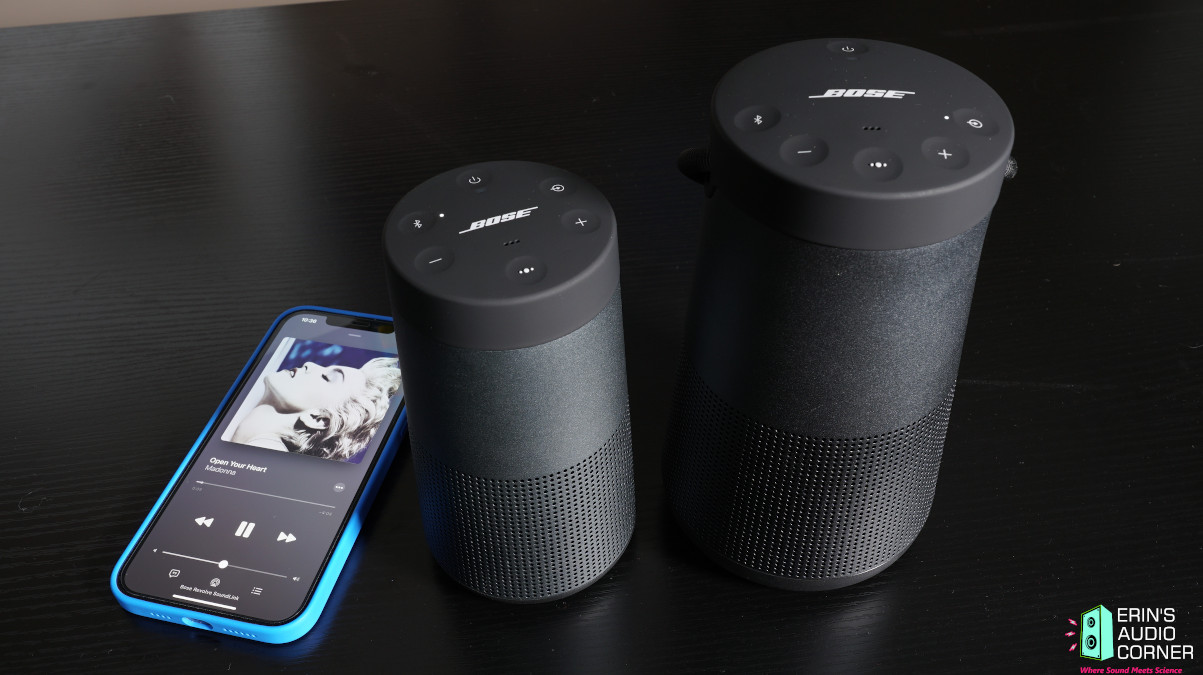
Foreword / YouTube Video Review
The review on this website is a brief overview and summary of the objective performance of this speaker. It is not intended to be a deep dive. Moreso, this is information for those who prefer “just the facts” and prefer to have the data without the filler.
Note: Coming Soon
For a primer on what the data means, please watch my series of videos where I provide in-depth discussion and examples of how to read the graphics presented hereon.
https://youtube.com/playlist?list=PLnIxFR_ey0b37Ex4KV2mBz-kYB7QLffR1
Information and Photos
The Bose SoundLink Revolve and Revolve+ are Bluetooth speakers. The design of these speakers are intended to provide 360° sound throughout the room and does so using a “fullrange” drive-unit with a waveguide paired with a set of passive radiators to provide the lower frequency content. See below photo for illustration.
Mechanically, the differences are in size and weight. The standard SoundLink Revolve is smaller and weighs about 0.50 lbs. less than the SoundLink Revolve+. The former has 12 hours battery life while the Revolve+ has 16 hours battery life.
Current MSRP for the Revolve is $180 USD and $250 USD for the Revolve+.


CTA-2034 (SPINORAMA) and Accompanying Data
All data collected using Klippel’s Near-Field Scanner. The Near-Field-Scanner 3D (NFS) offers a fully automated acoustic measurement of direct sound radiated from the source under test. The radiated sound is determined in any desired distance and angle in the 3D space outside the scanning surface. Directivity, sound power, SPL response and many more key figures are obtained for any kind of loudspeaker and audio system in near field applications (e.g. studio monitors, mobile devices) as well as far field applications (e.g. professional audio systems). Utilizing a minimum of measurement points, a comprehensive data set is generated containing the loudspeaker’s high resolution, free field sound radiation in the near and far field. For a detailed explanation of how the NFS works and the science behind it, please watch the below discussion with designer Christian Bellmann:
Given that this is a device that is less about “ideal listening conditions” and more about “convenience”, I am less interested in the absolute accuracy of the frequency response and more interested in the radiation pattern and the maximum SPL limits. In other words, most will be listening to this while moving about the home or as background music but I can’t imagine many attempting to use a SoundLink Revolve for “critical listening”. The goal of this review is to answer some basic questions: 1) What is the difference between the two versions, 2) what is the sound radiation characteristic and 3) which one gets louder.
With the above said, the reference plane in this test is at the waveguide level. Just above the bottom of the speaker. Volume set to max and signal was applied via the Aux Input. The speaker was measured fresh out of the box with no additional settings enabled (if they even exist). So there was nothing to disable in terms of “DSP”.
I modified the NFS to use a pole, placing the speaker on top rather than directly on top of the NFS’ platform. This was done to make sure there was no artifacts - comb filtering - from the stand back to the microphone as this is intended to provide anechoic data, as previously discussed. An example of this can be seen below from my Apple HomePod Mini test.

Measurements are provided in a format in accordance with the Standard Method of Measurement for In-Home Loudspeakers (ANSI/CTA-2034-A R-2020). For more information, please see this link.
Since this review is intended to be a comparison, I will provide a pair of results for each section and have removed some (redundant) graphics out of my typical review format to shorten the review. Bose SoundLink Revolve first. Followed by the SoundLink Revolve+. This should make it easier to compare as opposed to splitting the data over two separate reviews.
CTA-2034 / SPINORAMA:


Estimated In-Room Response:
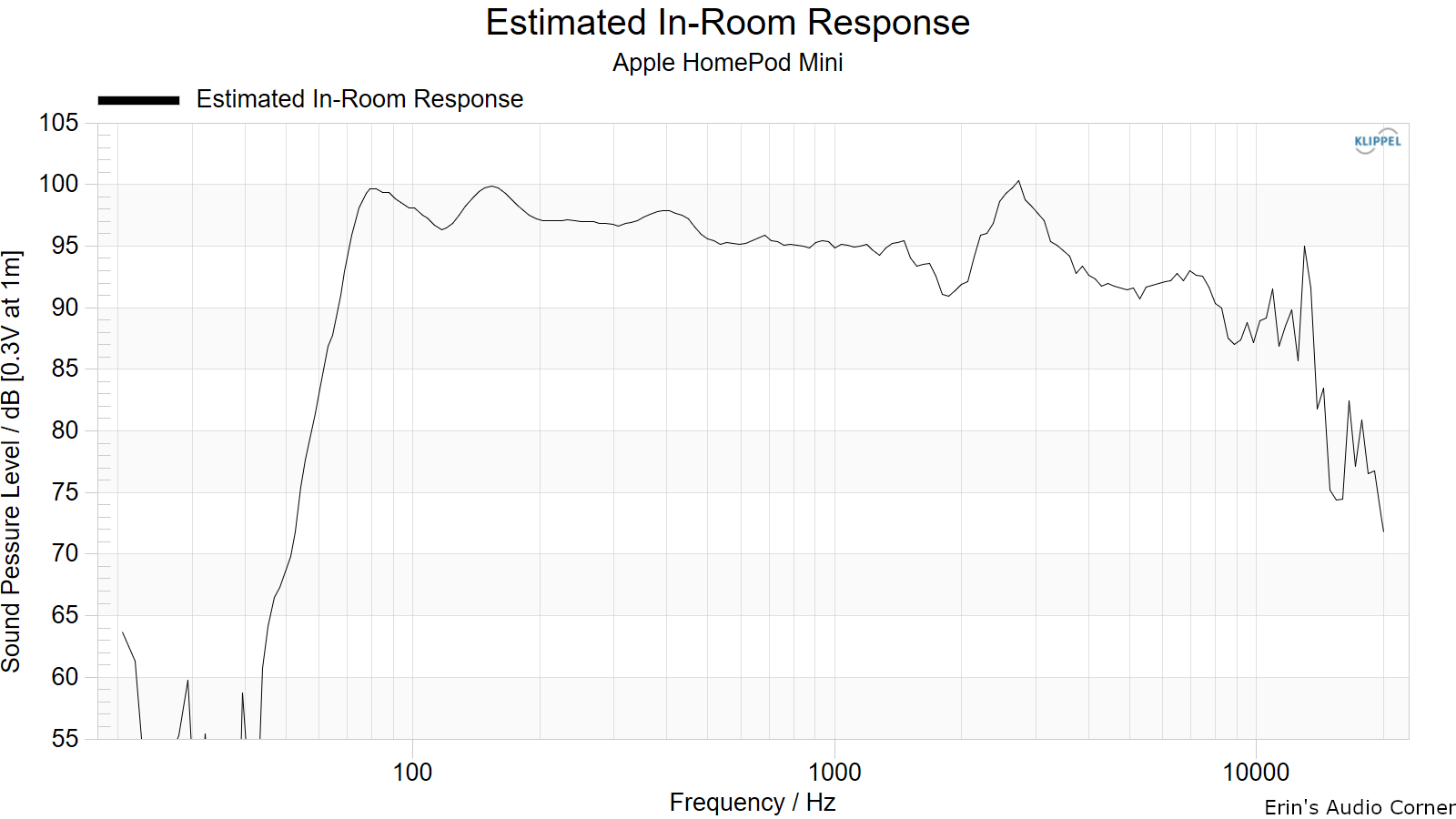

Horizontal Contour Plot (not normalized):


Vertical Contour Plot (not normalized):

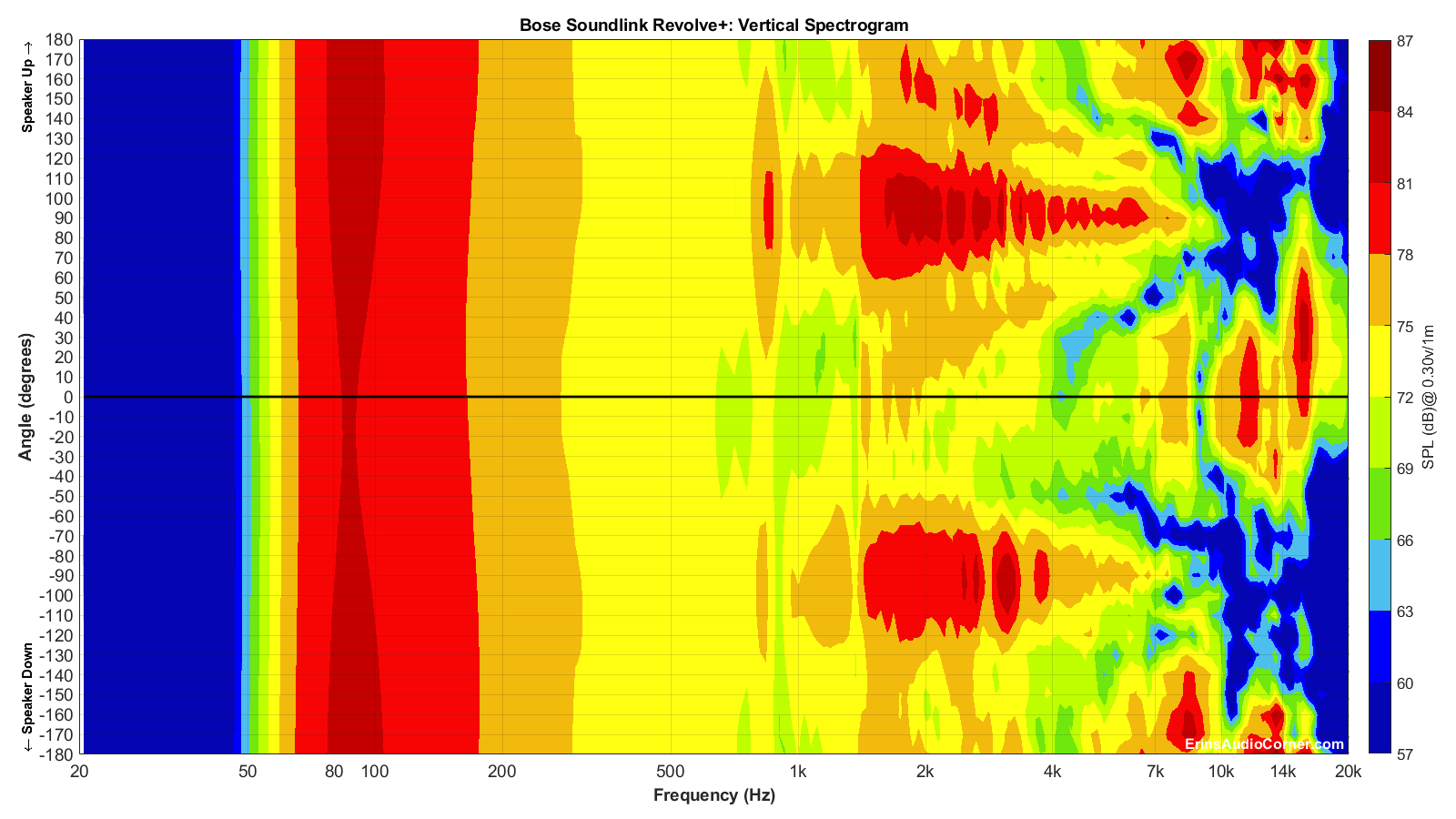
Additional Measurements
“Globe” Plots
These plots are generated from exporting the Klippel data to text files. I then process that data with my own MATLAB script to provide what you see. These are not part of any software packages and are unique to my tests.
Horizontal Polar (Globe) Plot:
This represents the sound field at 2 meters - above 200Hz - per the legend in the upper left.


Vertical Polar (Globe) Plot:
This represents the sound field at 2 meters - above 200Hz - per the legend in the upper left.
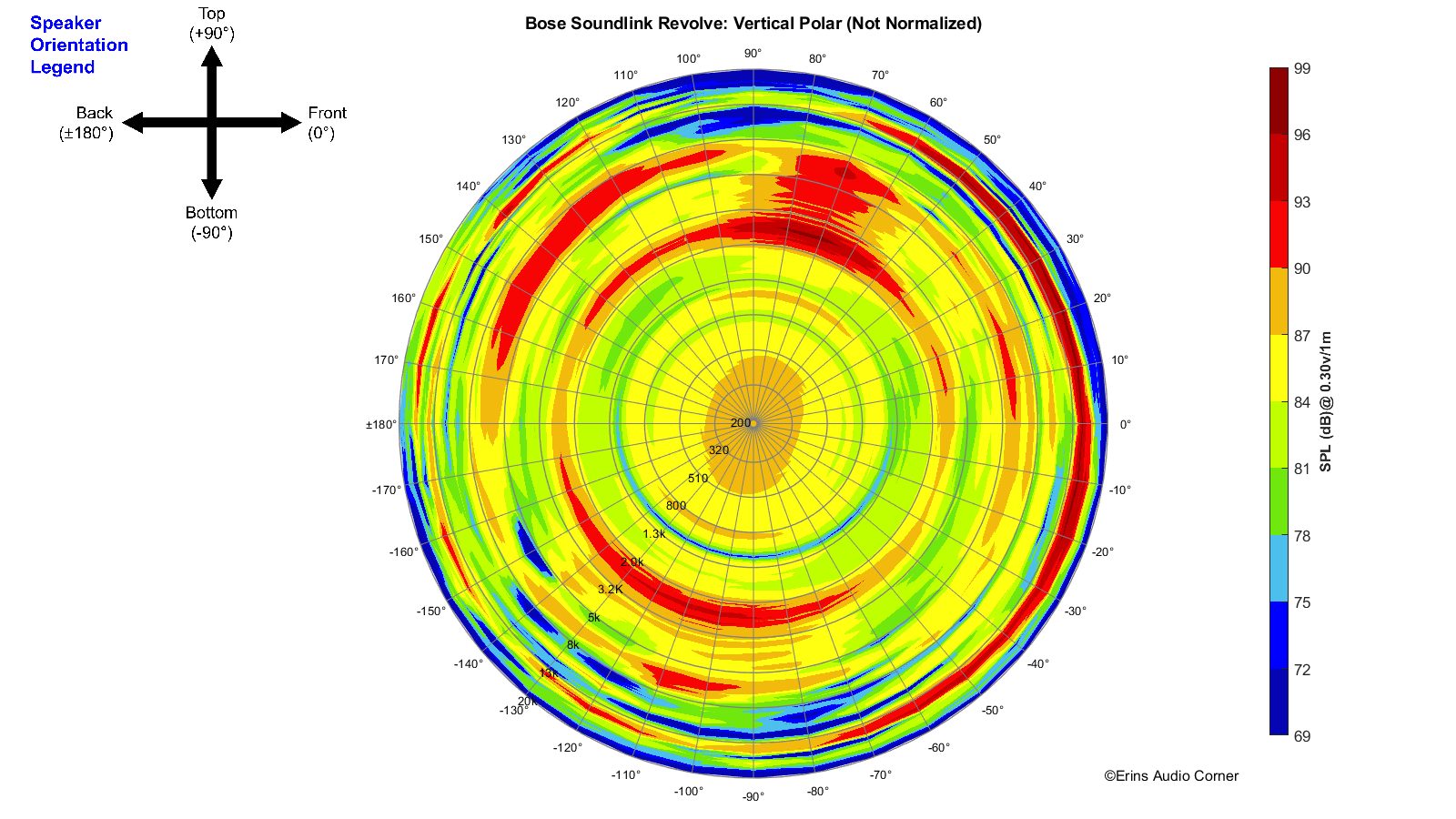

Harmonic Distortion
Harmonic Distortion at max volume (84dB @ 1m). This was literally the loudest I could set the SoundLink Revolve to play:
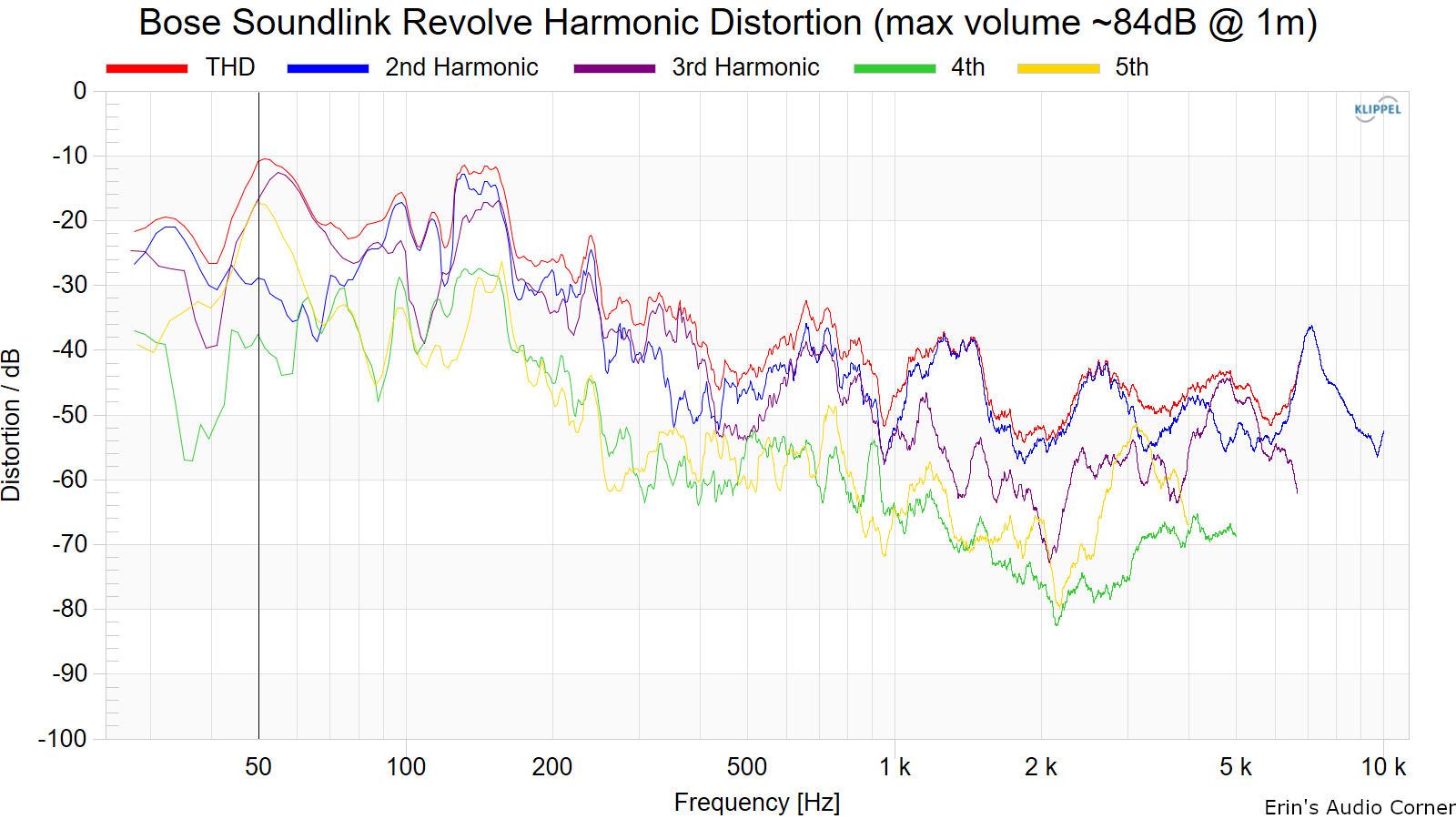
Harmonic Distortion at max volume (88dB @ 1m). This was literally the loudest I could set the SoundLink Revolve+ to play:

Dynamic Range (Instantaneous Compression Test)
The below graphic indicates just how much SPL is lost (compression) or gained (enhancement; usually due to distortion) when the speaker is played at higher output volumes instantly via a 2.7 second logarithmic sine sweep referenced to 76dB at 1 meter. The signals are played consecutively without any additional stimulus applied. Then normalized against the 76dB result.
The tests are conducted in this fashion:


You can clearly see a built-in limiter is used to keep from overpowering and blowing the speaker. However, the Revolve+ is capable of higher output.
Parting Thoughts
However, at lower levels where the bass does not need to be limited, I prefer the sound of the Apple HomePod Mini. It doesn’t have the low end response the Revolve+ does but it does generally sound more neutral (as neutral as a speaker like this can be).
Support / Contribute
If you like what you see here and want to help me keep it going, please consider donating via the PayPal Contribute button below. https://www.erinsaudiocorner.com/contribute/
https://www.erinsaudiocorner.com/loudspeakers/bose_soundlink_comparison/
Bose SoundLink Revolve vs Revolve+ Bluetooth Speaker
- Sunday, Jun 27, 2021
Foreword / YouTube Video Review
The review on this website is a brief overview and summary of the objective performance of this speaker. It is not intended to be a deep dive. Moreso, this is information for those who prefer “just the facts” and prefer to have the data without the filler.
Note: Coming Soon
For a primer on what the data means, please watch my series of videos where I provide in-depth discussion and examples of how to read the graphics presented hereon.
https://youtube.com/playlist?list=PLnIxFR_ey0b37Ex4KV2mBz-kYB7QLffR1
Information and Photos
The Bose SoundLink Revolve and Revolve+ are Bluetooth speakers. The design of these speakers are intended to provide 360° sound throughout the room and does so using a “fullrange” drive-unit with a waveguide paired with a set of passive radiators to provide the lower frequency content. See below photo for illustration.
Mechanically, the differences are in size and weight. The standard SoundLink Revolve is smaller and weighs about 0.50 lbs. less than the SoundLink Revolve+. The former has 12 hours battery life while the Revolve+ has 16 hours battery life.
Current MSRP for the Revolve is $180 USD and $250 USD for the Revolve+.

CTA-2034 (SPINORAMA) and Accompanying Data
All data collected using Klippel’s Near-Field Scanner. The Near-Field-Scanner 3D (NFS) offers a fully automated acoustic measurement of direct sound radiated from the source under test. The radiated sound is determined in any desired distance and angle in the 3D space outside the scanning surface. Directivity, sound power, SPL response and many more key figures are obtained for any kind of loudspeaker and audio system in near field applications (e.g. studio monitors, mobile devices) as well as far field applications (e.g. professional audio systems). Utilizing a minimum of measurement points, a comprehensive data set is generated containing the loudspeaker’s high resolution, free field sound radiation in the near and far field. For a detailed explanation of how the NFS works and the science behind it, please watch the below discussion with designer Christian Bellmann:
Given that this is a device that is less about “ideal listening conditions” and more about “convenience”, I am less interested in the absolute accuracy of the frequency response and more interested in the radiation pattern and the maximum SPL limits. In other words, most will be listening to this while moving about the home or as background music but I can’t imagine many attempting to use a SoundLink Revolve for “critical listening”. The goal of this review is to answer some basic questions: 1) What is the difference between the two versions, 2) what is the sound radiation characteristic and 3) which one gets louder.
With the above said, the reference plane in this test is at the waveguide level. Just above the bottom of the speaker. Volume set to max and signal was applied via the Aux Input. The speaker was measured fresh out of the box with no additional settings enabled (if they even exist). So there was nothing to disable in terms of “DSP”.
I modified the NFS to use a pole, placing the speaker on top rather than directly on top of the NFS’ platform. This was done to make sure there was no artifacts - comb filtering - from the stand back to the microphone as this is intended to provide anechoic data, as previously discussed. An example of this can be seen below from my Apple HomePod Mini test.
Measurements are provided in a format in accordance with the Standard Method of Measurement for In-Home Loudspeakers (ANSI/CTA-2034-A R-2020). For more information, please see this link.
Since this review is intended to be a comparison, I will provide a pair of results for each section and have removed some (redundant) graphics out of my typical review format to shorten the review. Bose SoundLink Revolve first. Followed by the SoundLink Revolve+. This should make it easier to compare as opposed to splitting the data over two separate reviews.
CTA-2034 / SPINORAMA:


Estimated In-Room Response:


Horizontal Contour Plot (not normalized):


Vertical Contour Plot (not normalized):


Additional Measurements
“Globe” Plots
These plots are generated from exporting the Klippel data to text files. I then process that data with my own MATLAB script to provide what you see. These are not part of any software packages and are unique to my tests.
Horizontal Polar (Globe) Plot:
This represents the sound field at 2 meters - above 200Hz - per the legend in the upper left.


Vertical Polar (Globe) Plot:
This represents the sound field at 2 meters - above 200Hz - per the legend in the upper left.


Harmonic Distortion
Harmonic Distortion at max volume (84dB @ 1m). This was literally the loudest I could set the SoundLink Revolve to play:

Harmonic Distortion at max volume (88dB @ 1m). This was literally the loudest I could set the SoundLink Revolve+ to play:

Dynamic Range (Instantaneous Compression Test)
The below graphic indicates just how much SPL is lost (compression) or gained (enhancement; usually due to distortion) when the speaker is played at higher output volumes instantly via a 2.7 second logarithmic sine sweep referenced to 76dB at 1 meter. The signals are played consecutively without any additional stimulus applied. Then normalized against the 76dB result.
The tests are conducted in this fashion:
- 76dB at 1 meter (baseline; black)
- 86dB at 1 meter (red)
- 96dB at 1 meter (blue)
- 102dB at 1 meter (purple)


You can clearly see a built-in limiter is used to keep from overpowering and blowing the speaker. However, the Revolve+ is capable of higher output.
Parting Thoughts
- Max SPL is 84dB @ 1m (SoundLink Revolve) and 88dB @ 1m (SoundLink Revolve+).
- Both speakers implement limiting to keep from blowing the speaker.
- The response of the Revolve+ is clearly boosted on the low end. Even when switching back and forth with music shows this to be the case even at the same volume. But as volume increases, the limiter kicks in and lowers the bass output on both units.
However, at lower levels where the bass does not need to be limited, I prefer the sound of the Apple HomePod Mini. It doesn’t have the low end response the Revolve+ does but it does generally sound more neutral (as neutral as a speaker like this can be).
Support / Contribute
If you like what you see here and want to help me keep it going, please consider donating via the PayPal Contribute button below. https://www.erinsaudiocorner.com/contribute/
Last edited: